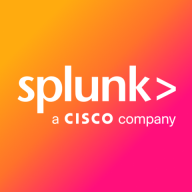

Find out in this report how the two Extended Detection and Response (XDR) solutions compare in terms of features, pricing, service and support, easy of deployment, and ROI.
We can quarantine and isolate a device within minutes.
Microsoft Defender XDR has saved me at least 50% of my time.
Ever since we turned on the M5 feature set back in June, we have seen a reduced number of potentially malicious clicks and faster alerting when incidents occur.
The documentation for Splunk Enterprise Security is outstanding. It is well-organized and easy to access.
We couldn't calculate what would have been the cost if they had actually gotten compromised; however, they were in the process, so every investment was returned immediately.
On average, my SecOps team takes probably at least a quarter of the time, if not more, to remediate security incidents with Splunk Enterprise Security compared to our previous solution.
You get stuck in low-level support for way longer than you should, instead of them escalating the issue up the chain.
It's critical to escalate SEV B issues immediately to a domestic engineer.
Once issues are escalated to the second or third layer, the support is much better.
We have paid for Splunk support, and we’re not on the free tier hoping for assistance; we are a significant customer and invest a lot in this service.
I have had nothing but good experiences with Splunk support, receiving timely and helpful replies.
We've had great customer success managers who have helped us navigate scaling from 600 gigs to 30 terabytes.
Microsoft Defender XDR shows tremendous scalability, much more so than on-premises solutions.
Microsoft Defender XDR scales pretty well.
It is suitable for enterprise-level deployment but has room for improvement.
We currently rely on disaster recovery and backup recovery, which takes time to recover, during which you're basically blind, so I'm pushing my leadership team to switch over to a clustering environment for constant availability.
They struggle a bit with pure virtual environments, but in terms of how much they can handle, it is pretty good.
It is easy to scale.
The service has remained consistently online, with any issues isolated to specific components, suggesting a well-designed and modular architecture.
The services within our ecosystem have been reliable, meeting their SLAs.
It provides high-fidelity signals.
They test it very thoroughly before release, and our customers have Splunk running for months without issues.
Splunk has been very reliable and very consistent.
It provides a stable environment but needs to integrate with ITSM platforms to achieve better visibility.
The licensing process needs improvement and clarification.
Improvements are needed in automated response capabilities.
Some inconsistencies exist between blades, which could be improved for a more seamless user and UI experience.
Improving the infrastructure behind Splunk Enterprise Security is vital—enhanced cores, CPUs, and memory should be prioritized to support better processing power.
Splunk Enterprise Security is not something that automatically picks things; you have to set up use cases, update data models, and link the right use cases to the right data models for those detections to happen.
For any future enhancements or features, such as MLTK and SOAR platform integration, we need more visibility, training, and certification for the skilled professionals who are working.
There are certainly savings when using Microsoft Defender XDR, which can range from 30%, 40%, and even up to 50%.
I would rate the pricing as eight out of ten, indicating it is a reasonable cost for the product.
Microsoft purposefully obfuscates this through marketing ploys to hide costs.
I saw clients spend two million dollars a year just feeding data into the Splunk solution.
The platform requires significant financial investment and resources, making it expensive despite its comprehensive features.
I find it to be affordable, which is why every industry uses it.
With Microsoft threat intelligence information, it detects various types of threats, including insider attacks, malicious content, and data exfiltration.
This allows us to secure our systems in advance and proactively improve security, rather than waiting for incidents to occur.
Once we have it on the security dashboard, we can see a real-time storyline.
This capability is useful for performance monitoring and issue identification.
I assess Splunk Enterprise Security's insider threat detection capabilities for helping to find unknown threats and anomalous user behavior as great.
Splunk Enterprise Security provides the foundation for unified threat detection, investigation, and response, enabling fast identification of critical issues.
| Product | Market Share (%) |
|---|---|
| Microsoft Defender XDR | 5.6% |
| CrowdStrike Falcon | 11.8% |
| Wazuh | 9.6% |
| Other | 73.0% |
| Product | Market Share (%) |
|---|---|
| Splunk Enterprise Security | 8.7% |
| Wazuh | 9.3% |
| IBM Security QRadar | 6.5% |
| Other | 75.5% |


| Company Size | Count |
|---|---|
| Small Business | 46 |
| Midsize Enterprise | 23 |
| Large Enterprise | 37 |
| Company Size | Count |
|---|---|
| Small Business | 110 |
| Midsize Enterprise | 50 |
| Large Enterprise | 257 |
Microsoft Defender XDR is a comprehensive security solution designed to protect against threats in the Microsoft 365 environment.
It offers robust security measures, comprehensive threat detection capabilities, and an efficient incident response system. With seamless integration with other Microsoft products and a user-friendly interface, it simplifies security management tasks.
Users have found it effective in detecting and preventing various types of attacks, such as phishing attempts, malware infections, and data breaches.
Watch the Microsoft demo video here: Microsoft Defender XDR demo video.
Splunk Enterprise Security delivers powerful log management, rapid searches, and intuitive dashboards, enhancing real-time analytics and security measures. Its advanced machine learning and wide system compatibility streamline threat detection and incident response across diverse IT environments.
Splunk Enterprise Security stands out in security operations with robust features like comprehensive threat intelligence and seamless data integration. Its real-time analytics and customizable queries enable proactive threat analysis and efficient incident response. Integration with multiple third-party feeds allows detailed threat correlation and streamlined data visualization. Users find the intuitive UI and broad compatibility support efficient threat detection while reducing false positives. Despite its strengths, areas such as visualization capabilities and integration processes with cloud environments need enhancement. Users face a high learning curve, and improvements in automation, AI, documentation, and training are desired to maximize its potential.
What Are the Key Features of Splunk Enterprise Security?In specific industries like finance and healthcare, Splunk Enterprise Security is instrumental for log aggregation, SIEM functionalities, and compliance monitoring. Companies leverage its capabilities for proactive threat analysis and response, ensuring comprehensive security monitoring and integration with various tools for heightened operational intelligence.
We monitor all Extended Detection and Response (XDR) reviews to prevent fraudulent reviews and keep review quality high. We do not post reviews by company employees or direct competitors. We validate each review for authenticity via cross-reference with LinkedIn, and personal follow-up with the reviewer when necessary.